The AMD Radeon R9 Nano Review: The Power of Size
by Ryan Smith on September 10, 2015 8:00 AM ESTCompute
Shifting gears, we have our look at compute performance.
Starting us off for our look at compute is LuxMark3.0, the latest version of the official benchmark of LuxRender 2.0. LuxRender’s GPU-accelerated rendering mode is an OpenCL based ray tracer that forms a part of the larger LuxRender suite. Ray tracing has become a stronghold for GPUs in recent years as ray tracing maps well to GPU pipelines, allowing artists to render scenes much more quickly than with CPUs alone.
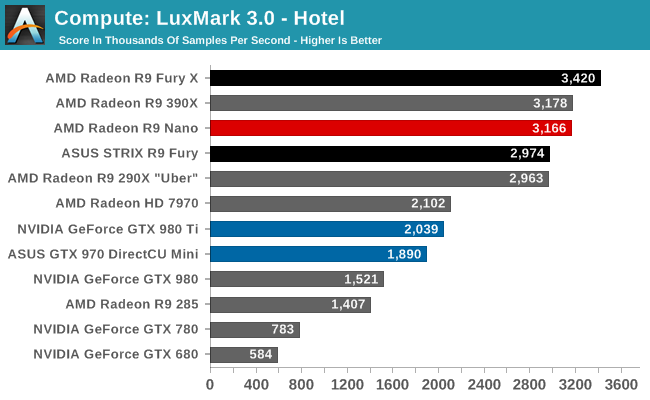
LuxMark ends up being a great corner case for where having a fully enabled Fiji GPU is more important than having the highest clockspeeds. With the R9 Nano able to flirt with its full 1000MHz clockspeed here, the card is able to pass the R9 Fury here. The only thing stopping it from taking the second-place spot is the R9 390X, as Hawaii still sees strong performance here even with fewer SPs.
For our second set of compute benchmarks we have CompuBench 1.5, the successor to CLBenchmark. CompuBench offers a wide array of different practical compute workloads, and we’ve decided to focus on face detection, optical flow modeling, and particle simulations.
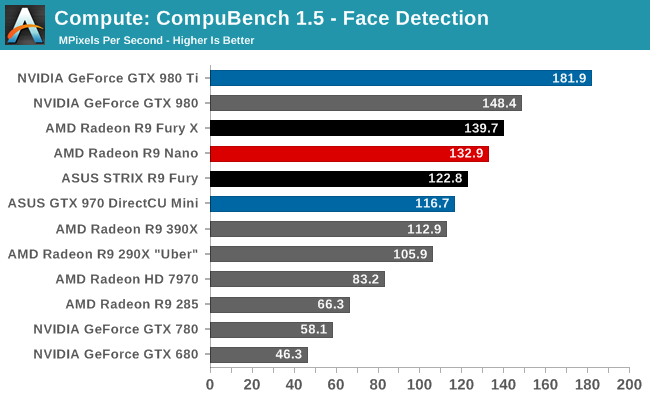
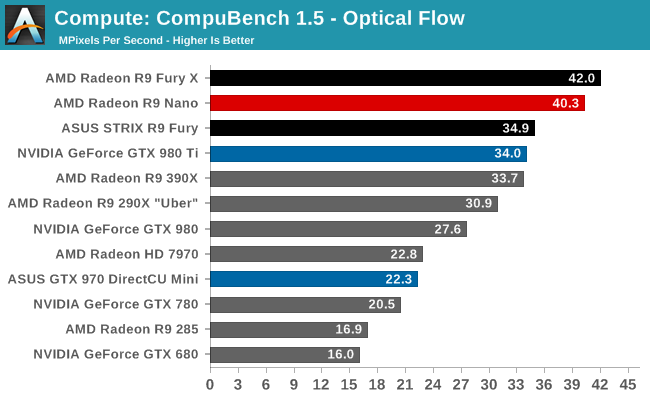
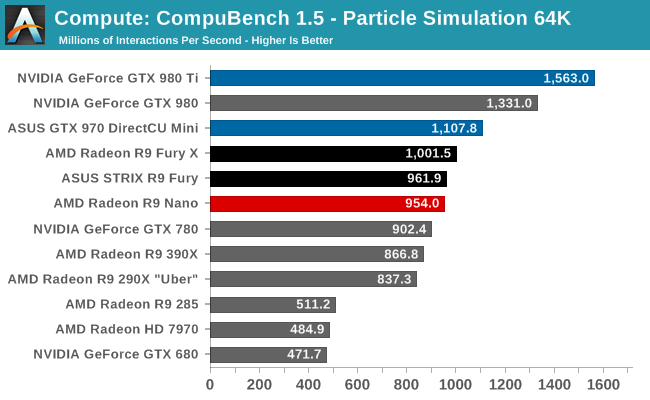
CompuBench provides us another case of where the R9 Nano ends up outpacing the R9 Fury. As a result AMD’s latest card tends to perform somewhere between an R9 Fury and R9 Fury X, with all of the strengths and weaknesses that come from that. This puts the R9 Nano in a good place for Optical Flow, while it will still trail NVIDIA”s best cards under Face Detection and the 64K particle simulation.
Meanwhile it’s interesting to note that AMD’s particle sim scores have significantly improved in the recent drivers. GCN 1.2 cards have seen 20%+ performance improvements here, which may point to some new OpenCL compiler optimizations from AMD.
Our 3rd compute benchmark is Sony Vegas Pro 13, an OpenGL and OpenCL video editing and authoring package. Vegas can use GPUs in a few different ways, the primary uses being to accelerate the video effects and compositing process itself, and in the video encoding step. With video encoding being increasingly offloaded to dedicated DSPs these days we’re focusing on the editing and compositing process, rendering to a low CPU overhead format (XDCAM EX). This specific test comes from Sony, and measures how long it takes to render a video.
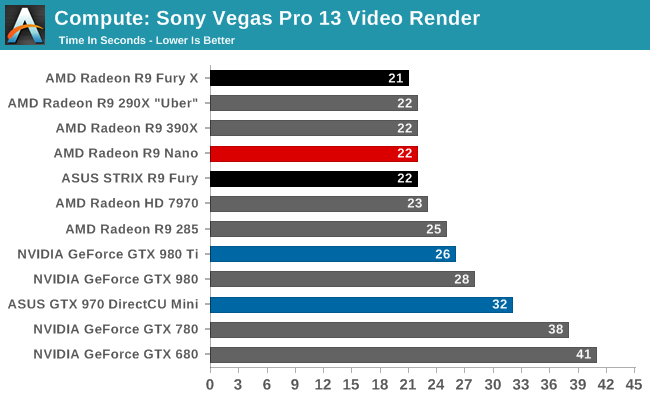
With Vegas there are no surprises; the R9 Nano ties the R9 Fury.
Moving on, our 4th compute benchmark is FAHBench, the official Folding @ Home benchmark. Folding @ Home is the popular Stanford-backed research and distributed computing initiative that has work distributed to millions of volunteer computers over the internet, each of which is responsible for a tiny slice of a protein folding simulation. FAHBench can test both single precision and double precision floating point performance, with single precision being the most useful metric for most consumer cards due to their low double precision performance. Each precision has two modes, explicit and implicit, the difference being whether water atoms are included in the simulation, which adds quite a bit of work and overhead. This is another OpenCL test, utilizing the OpenCL path for FAHCore 17.

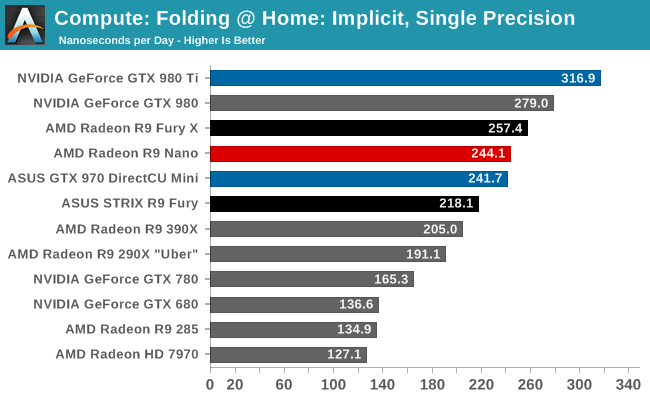
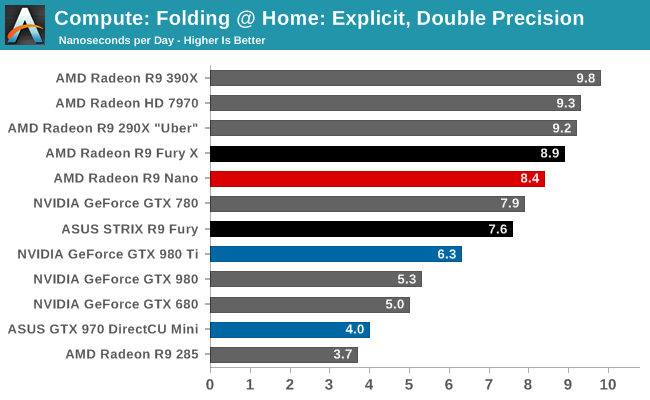
Much like CompuBench and LuxMark, the R9 Nano punches above its weight here. The lack of a graphics workload – and resulting demands on graphics hardware like the ROPs – means most of the card’s power can be allocated to the shaders, allowing higher clockspeeds. This gives the Nano a boost in this situation to bring it much closer to the Fury X, though as far as Folding goes AMD will still trail NVIDIA’s best cards.
Wrapping things up, our final compute benchmark is an in-house project developed by our very own Dr. Ian Cutress. SystemCompute is our first C++ AMP benchmark, utilizing Microsoft’s simple C++ extensions to allow the easy use of GPU computing in C++ programs. SystemCompute in turn is a collection of benchmarks for several different fundamental compute algorithms, with the final score represented in points. DirectCompute is the compute backend for C++ AMP on Windows, so this forms our other DirectCompute test.

Our final test sees the R9 Nano brought back to its place behind the R9 Fury, as the C++ AMP sub-tests are strenuous enough to cause more significant clockspeed throttling. Even behind the R9 Fury the R9 Nano does well for itself here, coming in behind the GTX 980 Ti and head of the R9 390X and GTX 980.










284 Comments
View All Comments
HOOfan 1 - Thursday, September 10, 2015 - link
Plenty of SFF cases fit full size cards now, unless you just have money burning holes in your pocket, why not buy one of those and get a regular non-X Fury or a 390X?przemo_li - Thursday, September 10, 2015 - link
ROTFL390X & 980 are TWICE as long.
That is SFF. Yeah, right. I will write SFF on my ITX tower. It will be so cool :P
trentchau - Thursday, September 10, 2015 - link
My Obsidian 250D is considered SFF (close to not being one) and it has a 980Ti in it. Why the laughter?HOOfan 1 - Thursday, September 10, 2015 - link
Fractal Node 202 will fit a GTX 980...are you going to tell me that is not small form factor?ingwe - Thursday, September 10, 2015 - link
For me there is a difference between a truly small form factor design and one that is "small form factor" but built to house a card twice as large as this. I am not saying this is an important distinction to everyone, but it is one that I would make. There is just a lot of size variability in mini-ITX cases.Your question though does really illustrate how much of a niche product this is though. You literally need to be going for the smallest package possible while retaining most of the performance--and not care about cost. It is an interesting product, but it is a mixed bag like the interview says.
tviceman - Thursday, September 10, 2015 - link
Clearly the Nano is a more interesting card to review but the obvious elephant in the room here is that Anandtech have completely dropped the ball on the last two major Nvidia releases (gtx 960 and gtx 950). Not only that, but you were also late with the Fury X review (being bed ridden can be a valid excuse but when deadlines are continually missed excuses run dry).Ryan you have great analysis, fair reviews, and strong writing. You've also had days, weeks (and months) to get reviews out (and on time) with the above mentioned cards and have failed to do so. You obviously need more help with reviews.
Oxford Guy - Thursday, September 10, 2015 - link
The 960 wasn't reviewed, most likely, because it was turkey.Gigaplex - Thursday, September 10, 2015 - link
How am I supposed to know it was turkey without either reading the review that doesn't exist, or buying one myself and being seriously disappointed? You don't just skip reviewing products that aren't very good, otherwise that defeats the point in reviews.K_Space - Friday, September 11, 2015 - link
@GigaplexI think Of is insinuating that Anandtech would not review a product that defaces nVidia (though I disagree). Getting the Nano review as a priority plus being chief editor (who probably proof reads other reviews), add in various administritive duties and it all takes its toll. The annual call up for reviewers has gone out recently; I think Anandtech made it clear enough they would love a helping hand in getting timely reviews... On time.
K_Space - Friday, September 11, 2015 - link
OG*